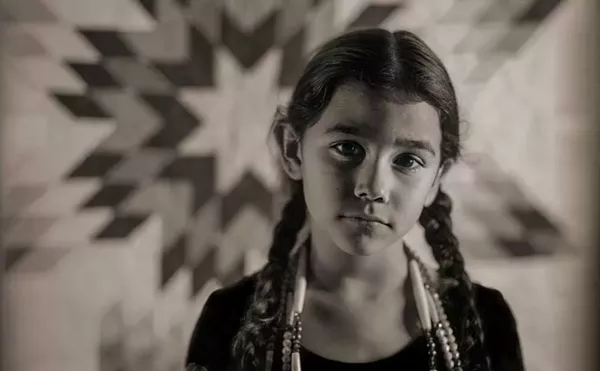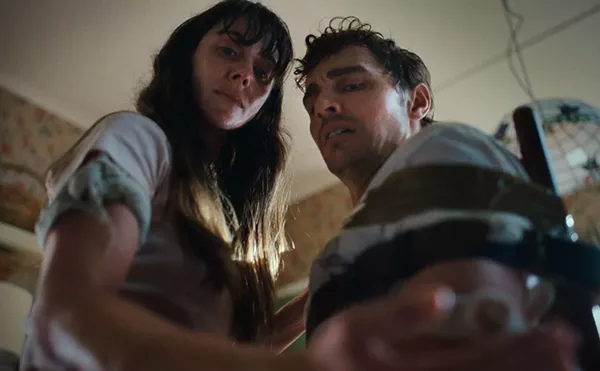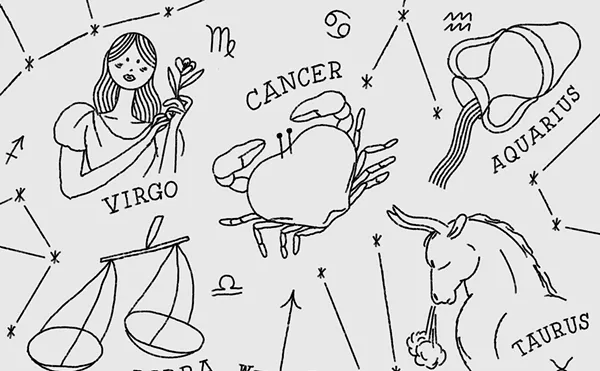
Audio By Carbonatix
[
{
"name": "GPT - Leaderboard - Inline - Content",
"component": "35519556",
"insertPoint": "5th",
"startingPoint": "3",
"requiredCountToDisplay": "3",
"maxInsertions": 100,
"adList": [
{
"adPreset": "LeaderboardInline"
}
]
}
]
"How much of human life is lost in waiting?" asks Professor Harold Oxley (John Hurt) in Indiana Jones and the Kingdom of the Crystal Skull. In the case of the fourth (and newest) Indiana Jones installment, nearly 20 years have been lost since the action hero has graced the silver screen. That's 20 years, folks!
Indiana Jones has lived a peculiar life. The scholarly archeologist first appeared in 1981's Raiders of the Lost Ark (a title since appended with his name to better fit in with the "Indy oeuvre"), in which he battled Nazis for possession of biblical treasure.
But the next Indy film left much to be desired. Though marketed toward adolescents, Indiana Jones and the Temple of Doom (1984) was a gruesome Indian adventure rife with human sacrifices, racism and cheap laughs. Decried by concerned parents, Temple of Doom paved the way for the MPAA's PG-13 rating.
The most offensive feature of this Indy prequel was the addition of a screaming female companion, Willie (director Steven Spielberg's wife, Kate Capshaw), plus cute kid sidekick Short Round (Jonathan Ke Quan). The cute-kid add-on usually signals a series that's jumping the proverbial shark. Sharks are in short supply in India but alligators are plentiful; they jumped those instead.
With no Short Round in sight, the third installment, 1989's Indiana Jones and the Last Crusade, triumphed. In retrospect, the film's an uneven mess and satisfies because the pendulum swung so far away from the mistakes in Temple of Doom. Rather than the juvenile cavorting that Steven Spielberg brought to Temple, The Last Crusade feels like a dry run for the damage producer George Lucas would inflict upon the world with his Star Wars prequels.
In fact, The Last Crusade recalled the third entry in the Star Wars series; if the Death Star worked swimmingly in the first Star Wars, let's bring it back in the third. Likewise, the Nazis and Biblical treasures from Raiders of the Lost Ark were trotted out for The Last Crusade. Sure, there weren't Ewoks around to defeat these dastardly villains but Marcus Brody (Denholm Elliot) and Sallah (John Rhys-Davies) were given lobotomies and set upon the Nazis, bumbling their way to victory.
The Last Crusade starts promisingly enough: River Phoenix captures the mannerisms Harrison Ford had brought to his Indiana Jones role. This quickly degrades into a series of obvious events that explains away the entire Indiana Jones mythos in minutes: The hat! The snakes! The whip! The scar! It's all there! Like overexplaining everything that went into making Anakin Skywalker become Darth Vader; it's not necessary to rob Indiana Jones of his mystery.
After The Last Crusade, Indiana Jones didn't have much luck as a TV character. On ABC's The Young Indiana Jones Chronicles (1992-1994, which saw Sean Patrick Flanery, Corey Carrier and George Hall tag-teaming the starring role), Indiana went from swashbuckler to tutor, incredibly interacting with more historical figures than Zelig. (Indiana Jones is only passing through history, he shouldn't be making it. Characters that appear at crucial turning points in history fit better in sci-fi television shows like Quantum Leap or Voyagers.)
At the 1994 Venice Film Festival, actor Harrison Ford professed that he would don Indiana Jones's fedora one more time if a compelling script were available.
The dead scrolls
Two viable scripts saw the light in 1995; Indiana Jones 4 by Chris Columbus and Indiana Jones and the Saucer Men from Mars by Jeb Stuart. The scripts by Stuart and Columbus are dated 10 days apart, supporting the idea that George Lucas commissioned several writers to work on scripts at the same time to choose the best ideas later.
Old Lucas doesn't like to give up his ideas. Back in 1973 he wrote an outline for what would later become Star Wars. It was called "The Journal of the Whills" all about "Mace Windy." It took 26 years before Samuel L. Jackson would portray the similarly named Mace Windu in The Phantom Menace. Likewise, the seeds of Kingdom of the Crystal Skull were sown 14 years before they finally saw the light of day.
Called Indiana Jones 4, Chris Columbus's script has since gotten two snappier titles; Indiana Jones and the Monkey King and Indiana Jones and the Garden of Life. Columbus's script exemplifies nearly everything wrong with the Indiana Jones series.
Similar to his father's quest for the Holy Grail, Indiana has long been searching for the remains of Sun Wu-Kung, the Stone Monkey God; the half-man, half-monkey guardian of the Garden of Immortal Peaches. Eat a peach, live forever! Marcus Brody shows Indiana a film of anthropologist Clare Clark and her latest discovery, Tyki, a 200-year-old pygmy with a peach-pit necklace.
Indiana wastes no time in heading to Africa where he hooks up with Scraggy, an old friend who speaks in platitudes that he must have stolen from a bag of fortune cookies. Matters get complicated when Indiana learns he didn't travel alone. His teaching assistant — the love-struck, low-class Brooklyn babe Betsy — has stowed away, determined to win the love of her paternal professor. Betsy is constant embarrassment to Indiana and to herself. Her presence doesn't do anything to win Clare's admiration, nor does it do much for the story other than provide some cheap laughs.
Monkey King pits Indiana against Nazis one more time. They're furious about his theft of the Ark of the Covenant. After fits and starts, the narrative becomes a ho-hum chase through the jungle with our heroes on the run from a battalion of Nazis armed with a tricked-out supertank and teaming up with a group of bloodthirsty pirates. As if it couldn't get any worse, the trail to Tyki's home leads to the "Land of City in Clouds" guarded by hyper-intelligent killer apes. The story spirals further into the realms of the ridiculous when head Nazi Gutterbuhg — sporting a machine gun arm — takes control of the city. Indy is briefly dead before Sun Wu-King resurrects our hero with a mystical Golden Hooped Rod.
Suffice to say, getting through Monkey King was a challenge. Not only was the story outlandish but it was poorly written. Columbus's script was crammed of description that didn't enrich nor advance the narrative.
Set in 1949, Jeb Stuart's script shows Jones feeling the aches and pains of his rough and tumble life. Rather than Nazis, he employs Cold War paranoia pitting Indiana against the Soviet Union. Stuart does well keeping the story moving while avoiding action scenes for the sake of action scenes.
Stuart's Saucer Men from Mars begins like Temple of Doom, with its revelation of the film's love interest, Elaine McGregor. McGregor is armed with the fighting spirit of Marion Ravenwood (unlike girly girl Willie) and the archeological expertise of Indiana Jones. By the first act's end, she and Indiana are about to step down the wedding aisle.
Poor Indiana is left waiting at the altar as his bride-to-be is driven away from the church minutes before the ceremony. A case of cold feet or did Indiana's whirlwind romance leave a few stones unturned about his betrothed's past?
McGregor's trail takes him to New Mexico where she's working for the U.S. government, using her linguistic skills to translate a stone cylinder that's been found in the desert, clasped in the hand of a dead alien.
The cylinder is something of a Rosetta stone, marked with Egyptian, Mayan, Sanskrit and Chinese pictographs. It's also a limitless source of power that the U.S. government aims to harness. Indiana and McGregor work to translate the cylinder but, before they can finish, Russian spies maneuver to steal it. The rest of the film consists of Indiana and McGregor chasing after the dirty commies to recapture the cylinder and avert Armageddon.
Stuart keeps his villains adequately ominous and plentiful. Aliens, though well-intended, are singular of purpose to fulfill their cosmic obligation by retrieving their cylinder regardless of who stands in their way. Meanwhile, neither the U.S. Army nor the Russians wish to give up a powerful item despite the consequences.
The Kingdom
Jeb Stuart's script contains several ideas that have been reworked by David Koepp and Jeff Nathanson for The Kingdom of the Crystal Skull. It includes appearances of an "Atomic Café," the scene of Indy visiting a bombing test town, a rocket sled, waterfalls, giant ants, and other scenarios that came to life in the 2008 film. Though Stuart doesn't get any screen credit, the name of his screenplay does when Indy scoffs about "saucer men from Mars."
Thankfully, little of Columbus's work survived in Kingdom of the Crystal Skull, apart from a thrashing tank and harrowing jungle chase. His intelligent apes are replaced by incongruous snarling natives that don't add anything to Kingdom. These were the roads not traveled. The potential sequels took the Indiana Jones legend along completely different paths —though with familiar scenery.
Amazingly, Kingdom avoids the pitfalls and tiger traps of previous post-Raiders Jones adventures. George Lucas hasn't pissed all over another cherished series. That's to say, Shia LaBeouf's Mutt Williams is not the second coming of Short Round or Jar Jar Binks. Jones has returned free of dismal comic relief, extraneous characters and cutesy references that stop the story in its tracks.
Recalling the mirth and mystery of Raiders of the Lost Ark, Kingdom is rife with fistfights, high adventure and (gasp) plenty of scenes of Indiana Jones exploring ancient ruins. If Temple of Doom and The Last Crusade were lacking any one thing, it was Jones doing what he did best; fighting through layers of cobwebs in search of items lost to antiquity.
The nearly two decades since Indiana Jones trotted off into the sunset in The Last Crusade have allowed story ideas to percolate and congeal in a fine, cohesive film and a return to adventure. Hold on to your hats (and your whips and guns), Indiana Jones is back.
Mike White is a freelance writer. Send comments to letters@metrotimes.com




